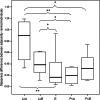The socio-matrix reloaded: from hierarchy to dominance profile in wild lemurs
- PMID: 25653908
- PMCID: PMC4304858
- DOI: 10.7717/peerj.729
The socio-matrix reloaded: from hierarchy to dominance profile in wild lemurs
Abstract
Dominance hierarchy influences the life quality of social animals, and its definition should in principle be based on the outcome of agonistic interactions. However, defining and comparing the dominance profile of social groups is difficult due to the different dominance measures used and because no one measure explains it all. We applied different analytical methods to winner-loser sociomatrices to determine the dominance profile of five groups of wild lemurs (species: Lemur catta, Propithecus verreauxi, and Eulemur rufus x collaris) from the Berenty forest (Madagascar). They are an excellent study model because they share the same habitat and an apparently similar dominance profile: linear hierarchy and female dominance. Data were collected over more than 1200 h of observation. Our approach included four steps: (1) by applying the binary dyadic dominance relationship method (I&SI) on either aggressions or supplant sociomatrices we verified whether hierarchy was aggression or submission based; (2) by calculating normalized David's scores and measuring steepness from aggression sociomatrices we evaluated whether hierarchy was shallow or steep; (3) by comparing the ranking orders obtained with methods 1 and 2 we assessed whether hierarchy was consistent or not; and (4) by assessing triangle transitivity and comparing it with the linearity index and the level of group cohesion we determined if hierarchy was more or less cohesive. Our results show that L. catta groups have got a steep, consistent, highly transitive and cohesive hierarchy. P. verreauxi groups are characterized by a moderately steep and consistent hierarchy, with variable levels of triangle transitivity and cohesion. E. rufus x collaris group possesses a shallow and inconsistent hierarchy, with lower (but not lowest) levels of transitivity and cohesion. A multiple analytical approach on winner-loser sociomatrices other than leading to an in-depth description of the dominance profile, allows intergroup and cross-species comparisons.
Keywords: Lemurs; Linearity; Madagascar; Prosimians; Sifaka; Social management; Steepness; Strepsirhines; Transitivity.
Figures




Similar articles
-
The Season for Peace: Reconciliation in a Despotic Species (Lemur catta).PLoS One. 2015 Nov 16;10(11):e0142150. doi: 10.1371/journal.pone.0142150. eCollection 2015. PLoS One. 2015. PMID: 26569400 Free PMC article.
-
Population ecology of the ring-tailed lemur, Lemur catta, and the white sifaka, Propithecus verreauxi verreauxi, at Berenty, Madagascar, 1981.Folia Primatol (Basel). 1986;47(1):39-48. doi: 10.1159/000156262. Folia Primatol (Basel). 1986. PMID: 3557229
-
Habitat use and social structure of a brown lemur hybrid population in the Berenty Reserve, Madagascar.Am J Primatol. 2007 Oct;69(10):1189-94. doi: 10.1002/ajp.20416. Am J Primatol. 2007. PMID: 17294429
-
Hierarchical development of dominance through the winner-loser effect and socio-spatial structure.PLoS One. 2022 Feb 2;17(2):e0243877. doi: 10.1371/journal.pone.0243877. eCollection 2022. PLoS One. 2022. PMID: 35108262 Free PMC article.
-
Relationship between dominance hierarchy steepness and rank-relatedness of benefits in primates.Behav Ecol. 2024 Aug 13;35(5):arae066. doi: 10.1093/beheco/arae066. eCollection 2024 Sep-Oct. Behav Ecol. 2024. PMID: 39193469 Free PMC article.
Cited by
-
Comparative Investigations of Social Context-Dependent Dominance in Captive Chimpanzees (Pan troglodytes) and Wild Tibetan Macaques (Macaca thibetana).Sci Rep. 2018 Sep 17;8(1):13909. doi: 10.1038/s41598-018-32243-2. Sci Rep. 2018. PMID: 30224738 Free PMC article.
-
The Season for Peace: Reconciliation in a Despotic Species (Lemur catta).PLoS One. 2015 Nov 16;10(11):e0142150. doi: 10.1371/journal.pone.0142150. eCollection 2015. PLoS One. 2015. PMID: 26569400 Free PMC article.
-
Hierarchies inferred from different agonistic behaviours are not always comparable.J Anim Ecol. 2024 Dec;93(12):1947-1959. doi: 10.1111/1365-2656.14203. Epub 2024 Oct 22. J Anim Ecol. 2024. PMID: 39435973 Free PMC article.
-
Social Network Analysis as a Tool in the Care and Wellbeing of Zoo Animals: A Case Study of a Family Group of Black Lemurs (Eulemur macaco).Animals (Basel). 2023 Nov 13;13(22):3501. doi: 10.3390/ani13223501. Animals (Basel). 2023. PMID: 38003118 Free PMC article.
-
A framework to evaluate whether to pool or separate behaviors in a multilayer network.Curr Zool. 2021 Feb;67(1):101-111. doi: 10.1093/cz/zoaa077. Epub 2020 Dec 26. Curr Zool. 2021. PMID: 33654494 Free PMC article.
References
-
- Alvarez F. Social hierarchy under different criteria in groups of squirrel monkeys, Saimiri sciureus. Primates. 1975;16:437–455. doi: 10.1007/BF02382741. - DOI
-
- Appleby MC. The probability of linearity in hierarchies. Animal Behaviour. 1983;31:600–608. doi: 10.1016/S0003-3472(83)80084-0. - DOI
-
- Bernstein IS. Dominance: the baby and the bathwater. Behavioral and Brain Sciences. 1981;4:419–457. doi: 10.1017/S0140525X00009614. - DOI
LinkOut - more resources
Full Text Sources
Other Literature Sources

